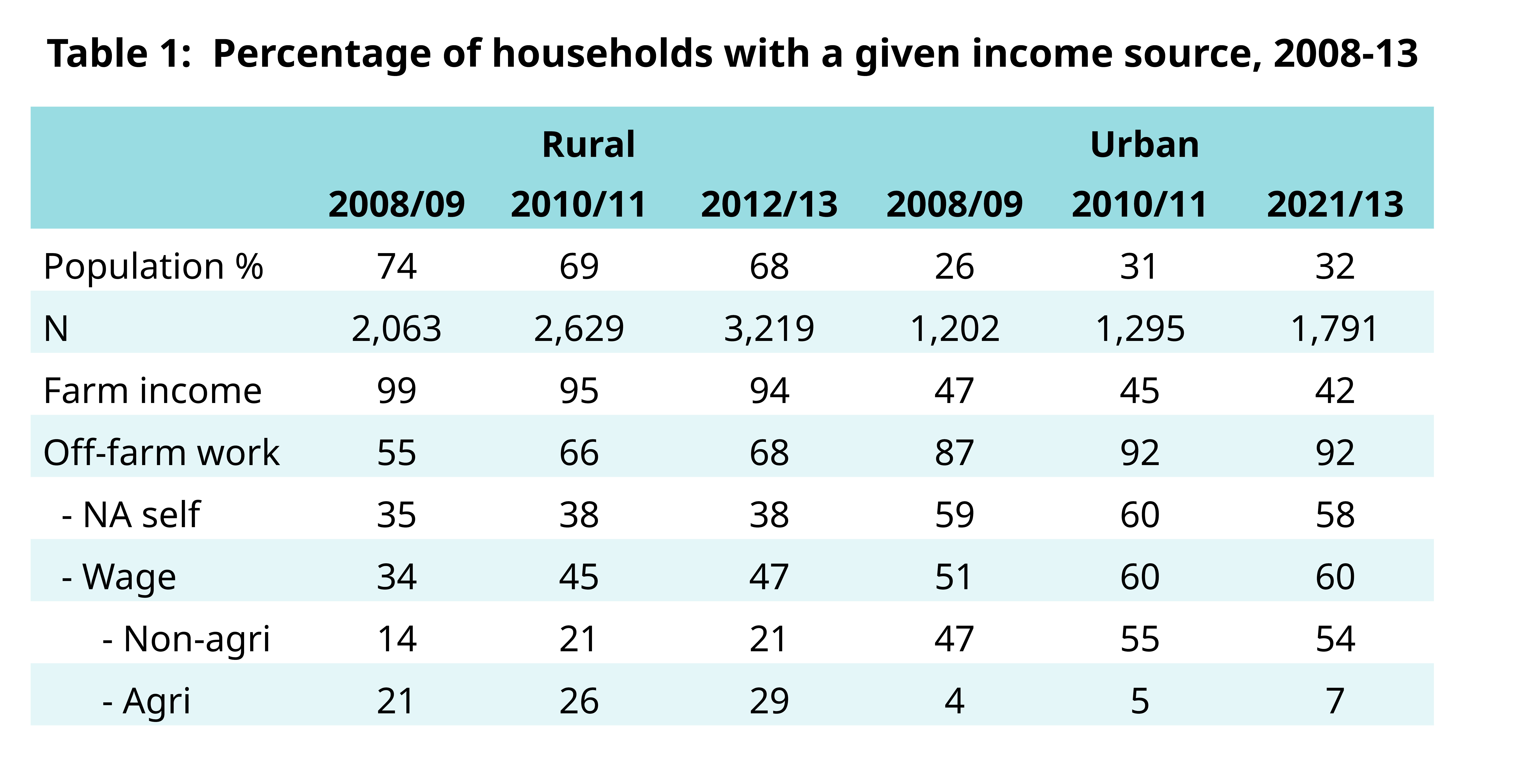Policy Brief
Better livelihoods through income diversification in Tanzania
Diversifying income sources is an important livelihood strategy for households in low-income countries. Having several sources of income helps in increasing total income, and in spreading the risks. New findings on the benefits of income diversification from Tanzanian households can inform policy aiming to develop welfare at the grassroots level and beyond.
Households in Tanzania have been able to diversify their sources of income during recent decades
Gender participation gaps declined: between 2008–13 the percentage of women with off-farm employment increased by a third
For rural households, most of the additional jobs for women are in low-paid agricultural wage employment, whereas men work more in higher paid non-agricultural wage employment
Low earnings in agricultural wage employment do not bring significant welfare benefits to households
Livelihood diversification into non-farm employment in rural areas appears to be more a result of an opportunity to accumulate income than a mere survival strategy
Infrastructural improvements have been an important factor in enhancing the income generation capacity of rural households in Tanzania
Income diversification and household welfare in Tanzania 2008–13
Households in Tanzania were able to diversify sources of their income over the five-year period from 2008–13. This is shown by answers in a national panel survey with more than 3,600 respondents. Diversification generally meant higher welfare, but there are differences by gender and type of activity.
To ensure comparability, in this analysis household income sources are separated into four labour categories: agriculture (farming), non-agricultural self-employment, agricultural wage, and non-agricultural wage employment.
The analysis shows that there has been significant growth in agricultural and non-agricultural wage employment, while the percentage of households with income from non-agricultural self-employment increased only slightly. The average number of wage workers in households has increased by almost a half, and growth has been faster for women. This indicates that gender participation gaps in wage employment are declining. For rural households, most of the additional paid jobs that women were engaged in are in agriculture but the earnings are low, suggesting that this does not increase household welfare. For men, the additional jobs are more evenly split between agricultural and higher paid non-agricultural wage employment.

Source: authors’ calculations based on Tanzania National Panel Surveys (NBS 2010, 2011, 2013).
In general, diversification appears to be more beneficial for rural households compared to their urban counterparts, but the higher welfare is associated with employment in non-agricultural sectors. In rural areas the positive benefit of off-farm employment is noticeably greater for men than for women, while in urban areas women benefit more than men.
There are several avenues for policy to support the income diversification and the welfare of Tanzanian households. Non-agricultural wage employment, irrespective of gender, means higher household welfare. Regional development strategies, which nurture local trade, services and manufacturing would be the best way to support such employment growth. Increased formal activity supports informal self-employment, so policies that improve infrastructure and reduce business constraints will support employment.
The relatively high growth of non-agricultural wage employment has contributed to increased welfare among households in Tanzania. Increasing education attainment is critical for the labour force to access non-agricultural wage employment. Although agricultural wage employment has been an important source of income, especially for women, it is not a beneficial diversification strategy as the earnings are low.
Efforts to improve agricultural productivity are required to increase potential earnings from farming and agriculture wages. Higher agricultural production will also deliver benefits to non-agricultural employment, for example through increased demand for services and inputs for agro-processing businesses.
Long run rural livelihood diversification in Kagera, Tanzania
But what drives rural livelihood diversification in developing countries? How can welfare enhancing patterns be established and sustained in the long run?
 A large literature has focused on whether livelihood diversification is a means of survival of relatively poor households or a means of accumulation by relatively better off households. Disentangling these two contrasting motives is of considerable policy importance.
A large literature has focused on whether livelihood diversification is a means of survival of relatively poor households or a means of accumulation by relatively better off households. Disentangling these two contrasting motives is of considerable policy importance.
This analysis first investigates the livelihood diversification behaviour of rural households in the Kagera region in Tanzania during 1991–94 and then compares it to a point in time ten years later in 2004. This approach enables examining how livelihood diversification changed over the 10-year period, as well as discussing the policy drivers underlying these changes.
The results indicate that accumulation motives explain the diversification behaviour of rural households in Tanzania more convincingly than survival motives — wealthier households were in a better position to diversify their incomes than relatively poor households. However, the situation of poor households improved as well. The key driver of welfare among the poor was entry into off-farm self-employment. Importantly, gaining access to public transportation enhanced livelihood diversification, while access to electricity, post and telecommunications, public transport and health facilities boosted household incomes. In sum, infrastructural improvements enhanced the income generation capacity of households in rural Kagera.
These results question the pessimistic view whereby household livelihood diversification in Africa is seen as a symptom of a failing agricultural sector. Instead, they show that livelihood diversification is a matter of choice rather than sheer necessity, with a potential of benefitting wealthy and poor households alike.
Non-agricultural wage employment and self-employment are beneficial irrespective of gender. Policies to support gender-inclusive employment and diversification opportunities are needed
Increasing education attainment is central for workers to be able to access non-agricultural employment
Increased efforts to improve agricultural productivity are essential to improve the welfare of rural households
In rural areas, investments in infrastructure, and easier access to financial institutions and rural markets is also crucial to support diversification. Households of the poor need to be prioritized
However, one should not ignore the potential of poverty traps preventing relatively poorer households from transitioning to high-income generation activities. Policy effort, particularly in the form of investments in infrastructure and easier access to financial institutions and rural markets, should thus prioritize poor households with the aim of pulling them out of the trap.
 Join the network
Join the network